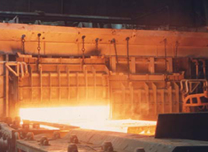Savings
Opportunities
Waste heat recovery
For most heating equipment, a large amount of the heat supplied is wasted in the form of exhaust or flue gases. These losses depend on various factors associated with the design and operation of the heating equipment. In most process heating applications, a large amount of the heat supplied is wasted in the form of exhaust or flue gases. In some cases the combustion products can still contain up to half of the thermal energy input into the system. This amounts to close to 50% waste-gas loss. The thermal efficiency of a heating system can be improved in one method by using the heat contained in furnace flue gases to preheat the combustion air going to the burners. A heat exchanger placed in the exhaust can transfer the thermal energy of the flue gas to incoming combustion air. Reducing the temperature of the flue gases will decrease flue gas losses, producing energy savings, and reusing the thermal energy in the flue gases will reduce the amount of purchased fuel the furnace requires. Savings from these kinds of recommendations can range from 6% to 25% depending on the method of heat recovery. Cost for exchangers and duct work can make this implementation expensive, but depending on the level of system inefficiencies , it can still be justifiable.
Improve combustion efficiency
Each fuel has a chemically correct (stoichiometric) amount of air required to burn it. Operating a heating system with an optimum amount of excess air will minimize heat loss via the flue gases. Inefficient operation can leave fuel unburned if too rich but sends too much hot gas out the stack if too lean. In addition, the O2 content is a measure of the combustion efficiency. Decreasing the O2 content without compromising the process itself can result in energy and cost savings. Additionally, reducing the amount of excess air within the flue gas will result in energy savings while maintaining the desired heat output or temperature within the furnace. Depending on the temperature of the exhaust gas and general system inefficiencies, the potential savings can be significant ranging from 10% and even up to 40% in some cases. These implementations can offer an attractive payback with low implementation expenses.
Insulate furnaces
The addition of more insulation over hot spots could reduce the energy lost to the surroundings. Reducing the heat load in the furnace by eliminating heat losses to the environment can result in energy savings. The energy savings from insulating exposed enclosure surfaces are low, but the relatively low implementation cost associated with this efficiency improvement project allow for short payback period.
Eliminate furnace openings or reduce opening time
The biggest radiant energy loss in furnace operations comes from leaving doors open longer than necessary or leaving doors partially open to accommodate a load that is too large for the furnace. Furnace openings not only waste energy through radiation losses, they also allow ambient air to enter the furnace and cause hot furnace gases to escape if the furnace pressure is not controlled. For openings such as a sight glass, use a damper or slide valve to block radiation when using the sight glass. These measures can reduce the radiation heat losses and reduce fuel cost. Savings from these projects can cover a wide range and so can the associated implementation cost and payback. Consideration should always be taken to insure that current production practices do not consume energy unnecessarily.


